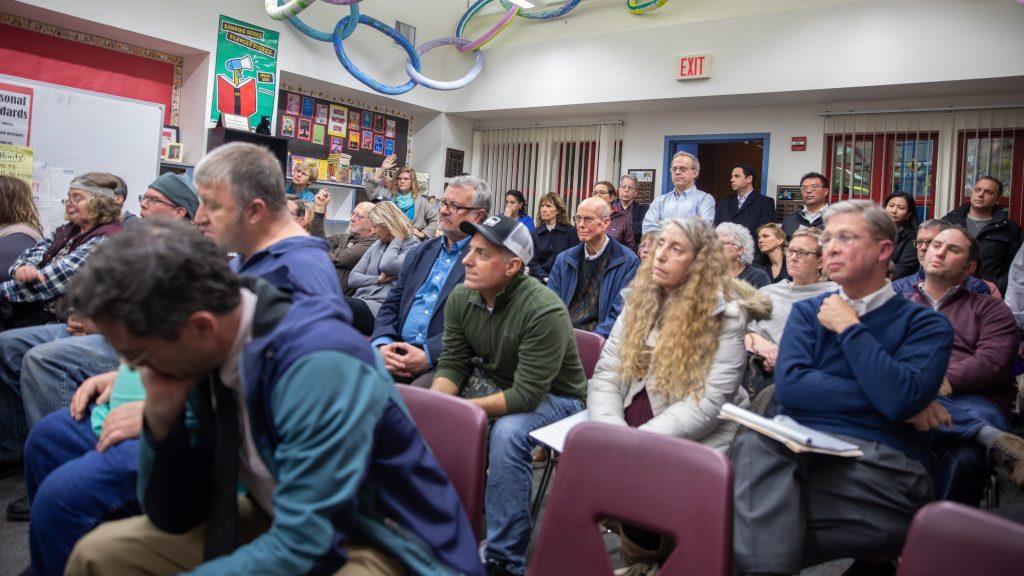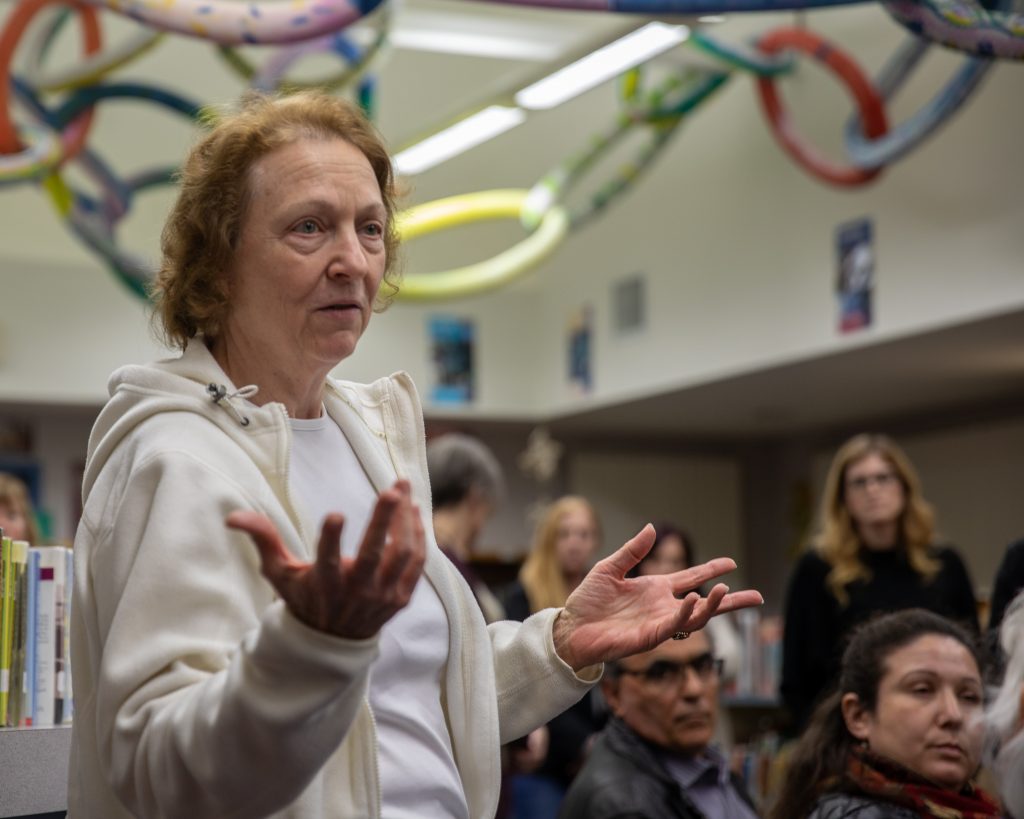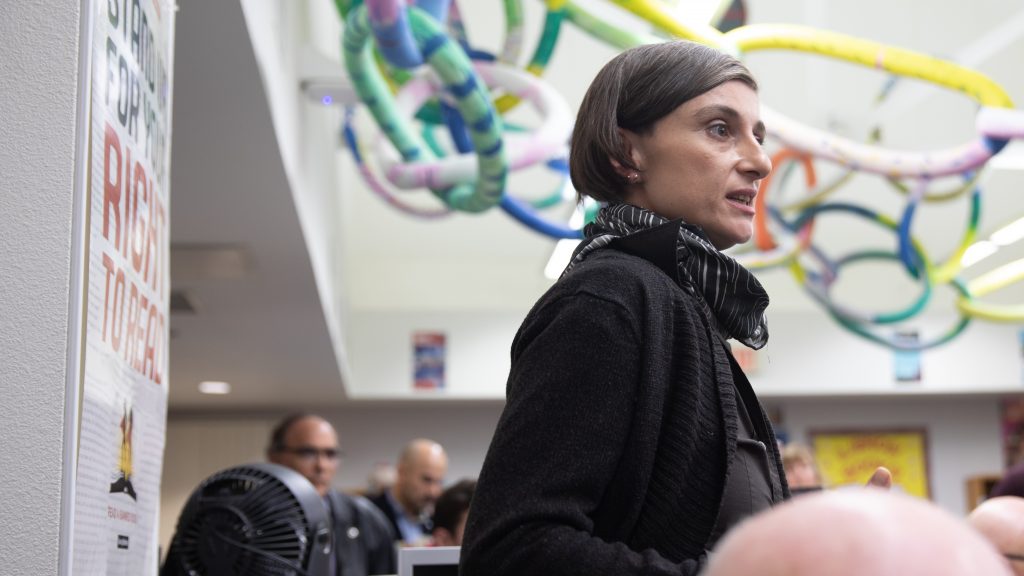
What was supposed to be an informational meeting on Thursday night at the overflowing library at Montgomery Elementary became a site of anger and frustration by many current neighbors of Pacifico, complaining about nuisance surrounding the current use of part of the facility – just as the county is looking to expand with the creation of a 16-person residential treatment facility and a navigation program expected to serve perhaps 10 to 15 people per week.
As one of the providers pointed out, Davis is in need of facilities to treat the mentally ill. He explained that he has been providing services for the mentally ill for 32 years, but they have never done it before in Davis – even though he himself lives in Davis.
The proposal calls for taking three floors in two buildings that are currently offline and providing space and round-the-clock  staffing for 16 residents. They are applying for a conditional use permit.
staffing for 16 residents. They are applying for a conditional use permit.
Neighbors are complaining that the existing use is a problem – some went so far as to say that if the entire facility were going to be the proposed use, they would support it.
County and other stuff were forced to respond to a chaotic and rapid fire start that short-circuited the process, but eventually gave way to a still heated but more orderly give and take.
The purpose of the community care licensing, staff explained, was to give people suffering from mental illness life skills training, whereby they can partake in independent living.
He explained, “We pride ourselves by being invisible in the community.”
The people who would be served are those with chronic mental health conditions and serious mental illness which impairs their ability to learn. While some may have criminal records, they stressed this is not a place where violent criminals or those charged with sex offenses would go.
The average stay for residents would be 18 months, where drug use is monitored and hopefully stabilized.
In the midst of this frustration, there were also people in attendance who utilize and rely on these services and who were offended by some of the responses.

A woman stood up to tell the story of her daughter. She was a 14-year-old high achieving student in Davis schools, who one day told her mother she was suicidal and over the course of the next few years they struggled with the district in order to access services.
Another person pointed out that Pine Tree Gardens serves very similar populations with similar programs. The man said that he was not aware of any problems with the Pine Tree Gardens people. Most of the residents of that facility are simply happy to have a home, they treat it like a home and they are largely invisible to those surrounding residents.
It also became clear that many of the complaints were not about the new planned uses but the existing uses in buildings C and D, where students, low income individuals and all sorts of other folks are living. Some staff suggested that current residents are actually victims as well, as the problem may be more outsiders coming from the bike path that are causing problems.
Matthew Lang, a resident of the neighborhood, told the group, “I live next door to Pacifico co-op, and I know they’re there.
“The idea that there was extensive community outreach was a joke,” he said. “Now you’re talking about putting a residential treatment facility right next to people who are doing meth.”
He also explained that the graffiti “I love meth” was spray painted in front of his home.
“Students have needs too,” he said. “This was originally a student facility. Let’s make it what it was.”
“I think a lot of you are very disrespectful,” a woman said. “My friends, I work with them. They need a place to live.”
She continued, “Everyone has problem, these are people in our community and these are the people we love.”
She added, “We are here, this is our community.”
She talked about the need for a facility in Davis instead of forcing people to go to Woodland and West Sacramento. She said, “Try to get out to the mental health facility – it’s hard, it’s hard even when you’re driving.”
Another resident, Tracy DeWitt, explained that she was a longtime resident, but it was not until 2011 when the facility changed ownership and purpose that she began having problems.
“In 2011 when you guys purchased the property was the first time I had experienced a problem,” she said. “I want to find a new place to live – because I don’t feel safe”.
She added, “My life feels threatened”
She continued, “That’s being threatened and it’s been going for years. I have no faith in Yolo County Housing, because you guys have a history for not taking care of your property.”
Ms. Dewitt stated, “Now you want to add a whole mental health component for the county? You are insane, you can’t even handle what you have.”
“The existing use is really worrying to the people in the neighborhood,” John Slater, another neighbor, said.
But he explained, “It’s not that we’re worried about a mental health facility, it’s that the way it’s run now it should not be added to…”
He said they would prefer an all-residential facility rather than deal with the current uses. He argued that the city needs to address the current uses.
He explained, “If it were all going to be a residential facility – you would have more support.” He added, “The concerns are not about the new uses – the concerns are about additional uses.”
Mr. Slater suggested that they withdraw the request for the CUP, address current problems, and then re-file for the CUP.
The providers explained that they believe that a lot of the problems are coming from the outside and they will look into mitigation measures. The neighbors complained that when they do complain, they often cannot find a manager on site to complain to.
There was some dispute as to whether management was there or not. However, a woman who managed the student housing next door did acknowledge that in the past few months that things have improved and they have been more responsive.
On the other hand, Matthew Lang suggested that a recent development on Mace had given its in-lieu fees to Pacifico. He explained, “What they are doing is concentrating into one facility that has a lot of beds a huge number of people with mental illness.
“We are actually ‘ghettoizing a neighborhood,’” he explained, likening it to Cabrini Green, the facility from Chicago. He suggested instead of one large facility that concentrates the population, we should have a bunch of small facilities across the town to service those needs.

Another woman spoke up. She explained that she is a user of mental health facilities and may stutter, but she said, “The coalition I am part of shares your concern.”
She said, “What you’re looking at is an improvement in all of the areas that you are afraid of at the moment.”
The woman explained, “As concerned as you are about your property – I am that concerned about my community.”
She noted that “Yolo County is the envy of every state in this nation and everyone on this planet.” She argued, “This program is going to change the lives of people like me and every one of our lives.”
Staff explained that the navigation program will help service people who are largely out-patients. Right now there are fairly established mental health services in Woodland and West Sacramento and their intention is to really serve Davis residents.
They are currently providing services for eight people a week on A Street. “We are not serving over ten folks a week,” she explained, on A Street due to limited space at the A Street County offices. “Our goal is to do about ten per week.”
One of the providers explained, “Individuals who want mental health care in Davis have to go to Woodland and West Sac for help.. If someone new needs help, they have to go to other cities.”
Another woman spoke up and applauded those with mental health illnesses who have spoken up. She said, “I personally would have no problem moving into a place next to this.
“I wholeheartedly support this project going in,” she said. “The project will mitigate some of the things people are complaining about.”
Nancy Temple, who was the head of Yolo NAMI (National Alliance on Mental Illness) for 15 years, warned that, while Pine Tree Gardens functions well, it is in financial trouble and they could end up closing – forcing about 30 homeless people to be sent out of county. She warned people to Support Pine Tree Gardens and noted “a certain irony here.”
There will be more formal outreach as this plan progresses. One thing that residents complained about was lack of notice for previous meetings. Currently there is an application for a conditional use permit going through the city, which is the owner of the land, even as the county would run it.
—David M. Greenwald reporting







The timing of this meeting ironically coincides with last night’s airing on the PBS NewsHour of the latest installment of the Brief But Spectacular series that featured Jerri Clark story about her son Calvin who was in college when his erratic behavior began, eventually leading to a diagnosis of bipolar disorder. His run-ins with law enforcement convinced Clark that medical and legal systems have very little tolerance for individuals with serious psychiatric issues. In the seven minute segment she shares her brief but spectacular take on why mental illness ‘should never be a crime.’
To view a video of the segment click on the following link. https://youtu.be/1ozj7TvpDHI
http://www.youtube.com/watch?v=1ozj7TvpDHI&w=560&h=315
“drug use is monitored and hopefully stabilized.” That’s the “Housing First” perspective. It’s interesting how many people love Housing First until they realize it means living next to people with untreated mental illness and people who are continuing to smoke meth. There is it people.
I think you’re conflating the existing residents with the planned program. This is a complex issue and it would be helpful to peel back the layers to determine where the problem is and how best to address the concerns (the existing concerns) of the neighbors.
It is not at all complex. it would be difficult to have anything be more simple. If you take people with mental health problems and substance abuse issues so severe that they are homeless, and put them in apartments while they continue to use, you are going to have problems of this nature. You can hope that they “stabilize”, whatever that means, but they are not going to be good neighbors.
Any program that allows drug and alcohol use will be a disaster for the neighborhood.
As I read this, there are two different populations. One is the existing population which is not necessarily mentally ill. And the other is the proposed population who would be people with mental illness. It appears you are trying to blame the problems on the group of people who are not yet there. Am I misreading you?
The results are an “expected outcome” of the project design.
JH, nailed it.
The current use is vague. Sounds like a no-man’s land of anarchy and meth addiction.
Love the “proprietors” blaming it on “people from the bike path”.
Harm reduction vs abstinence-only programs:
https://www.ncbi.nlm.nih.gov/pmc/articles/PMC3675178/
Thanks for digging this up, Don. But the insider language! Arghh! At least there are nuggets of plain language that explain how complicated and difficult this problem is:
This is pretty clear
“program policies consistent with a Housing First approach do not consider alcohol or drug use in and of itself to be lease violations”
Hence the issues discussed above.
Saw this in the Chronicle:
”On housing, Newsom proposed $500 million in state aid to cities to open Navigation Centers like those pioneered by San Francisco, where homeless people have access to programs such as drug and mental health counseling and job searches. He proposed waiving environmental requirements for building such shelters, much as cities do for stadium projects.”
San Francisco, the City that inspired an app to report the location of human poo.
“Navigation centers are an essential part of the equation because they provide critical support services to help homeless individuals off the streets long-term,” Assemblymember Phil Ting said.
I find it interesting the complaint some here made about Housing First was providing housing without support services, well here’s a program that provides support services and it’s also being criticized.